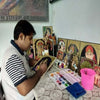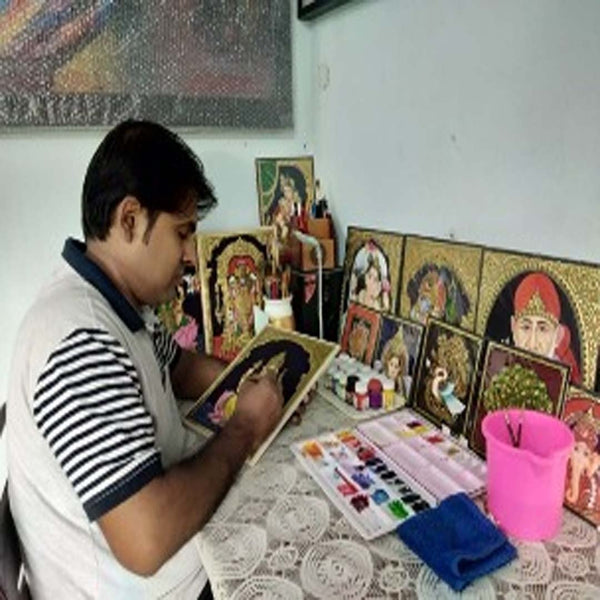EMI available: Pay in installments with your preferred Credit/Debit cards.
![]() Get Upto 10% OFF on purchase of this product.
Get Upto 10% OFF on purchase of this product.
![]() Get upto 10% OFF on Live Workshops when sign up for 2 or more workshops.
Get upto 10% OFF on Live Workshops when sign up for 2 or more workshops.
![]() Get 10% OFF coupon code for Art Kits signing up for Masterclass or Live Workshop.
Get 10% OFF coupon code for Art Kits signing up for Masterclass or Live Workshop.
![]() Earn upto 7,750 Points on purchase of this product.
Earn upto 7,750 Points on purchase of this product.
ONLINE DIWALI SPECIAL TANJORE WORKSHOP BY SANJAY TANDEKAR
This workshop is now over, you can buy recordings.
Sanjay Tandekar, a traditional Tanjore painting artist from will guide you with the process and techniques during the workshop.
This is a BEGINNER FRIENDLY workshop and the following steps will be covered in this 5 day workshop. Tanjore paintings are created with real gold foil (22k Gold). As
Diwali coming up soon, we thought it would be apt to paint a beautiful Tanjore painting of Lord Ganesha.
This Diwali brighten your homes with intricately designed and ornate painting of Lord Ganesha.
The dark background is decked with a golden border, embedded with colorful stones. Lord Ganesha seated gracefully on the throne, with Mushak Raj at his feet. May the Lord bring you wealth and well-being.
This is going to be a beginner’s friendly workshop, for 5 days you will be guided on to make these artworks. In the beginning, you will be drawing a sketch on a base which is made up of cloth, this cloth is pasted on a wooden base, making a muck board. Then chalk powder is mixed with water-soluble adhesive and applied on the base. After this is done, the sketch is made and is decorated with semi-precious stones. Other objects like threads and laces are also used to decorate it more, it's optionable for you to have it at your disposal. To make the paintings more magnificent, thin sheets of gold are pasted on parts of the painting. You will be indulging in various techniques like tracing, coloring and shading.
- Tracing , coloring and shading techniques
- Single layer cone work
- Gold foil work
You can also signup for the Tanjore Lakshmi workshop if you want to create both Lakshmi and Ganesha artworks for Diwali and avail a 10% discount only if you signup for both workshops together. (the discount will apply automatically in your cart if you add both)
The following materials will be sent in the art kit for this workshop:
- Bigger Muckboard (Size: 10/12 inches) -this is the traditional board made by the artist for Tanjore art (we will not be covering making the board in the workshop) . In earlier workshops we have worked on a 8 by 10 inches board and this time as the painting has more work thus we are working with a bigger board.
- Gold foil sheets (22k gold)
- Arabic gum
- Stones in different sizes as required in the artwork (not precious stones)
- Chalk powder
- Artwork and tracing paper
- Red/Yellow carbon paper
- Plastic sheet to make cones
- Fevicol
- Cello Tape
- Paper cutter
- Gold Color
At your end please also have the following materials:
- Thread to tie the cone
- Scissors
- Pencil and rubber
- Poster colours (acrylic colours are also ok but poster colors are preferred) and colour pallete
- Brushes
- A smooth silky material cloth- small piece just to pat the gold foil when pasting it
- Please have a hair dryer with you so that the cone work can dry quickly in the first workshop and we can start the gold foil work
We hope you can join us to support the arts and artists.
If you would like to purchase both Lakshmi and Ganesha workshops and get 20% off on both, please buy this bundle.
We ship worldwide, shipping charges of 2000 INR are applicable for international orders. Our Prices are inclusive of GST/Taxes. No additional charges are applicable for domestic deliveries.







